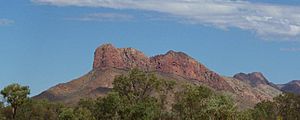Tjunkiya Napaltjarri facts for kids
Quick facts for kids
Tjunkiya Napaltjarri
|
|
|---|---|
| Born | 1927 North-west of Kintore, Northern Territory
|
| Died | 2009 (aged 81–82) |
| Nationality | Australian |
| Known for | Painting |
Tjunkiya Napaltjarri (born around 1927, died 2009) was an important Indigenous artist from the Western Desert area of Australia. She spoke the Pintupi language. Tjunkiya was the sister of another famous artist, Wintjiya Napaltjarri.
Her beautiful paintings are displayed in big art galleries. These include the National Gallery of Australia and the Art Gallery of New South Wales. Her art is also in the Museum and Art Gallery of the Northern Territory and the National Gallery of Victoria.
Contents
Tjunkiya's Life Story
Tjunkiya was born around 1927. It is hard to know the exact year. This is because Indigenous Australians often remember dates differently. They might compare them to other important events.
Her "skin name" was Napaltjarri. This is a special name used by central Australian Indigenous people. It helps show how families are connected. It also helps decide who people can marry. These names are not like surnames in other cultures. So, 'Tjunkiya' is her unique name.
Tjunkiya was born near Walungurru (also known as Kintore, Northern Territory). This area is close to the border of Western Australia. After she was born, her family moved to Haasts Bluff.
She became the second wife of Toba Tjakamarra. He was the father of Turkey Tolson Tjupurrula. Turkey was one of the main artists who started the Papunya Tula art movement. Tjunkiya had ten children at Haasts Bluff. Her sons Billy Rowe and Riley Rowe also became painters. Her daughter Mitjili also painted at Haasts Bluff.
Later, her family moved to Papunya. In 1981, they moved to Kintore. Tjunkiya was the sister of artist Wintjiya Napaltjarri. Wintjiya was also a wife of Toba. Tjunkiya passed away in 2009.
Tjunkiya's Art
How Western Desert Art Began
Modern Indigenous art from the Western Desert started in 1971. Indigenous men in Papunya began painting with help from a teacher, Geoffrey Bardon. They used acrylic paints to create designs. These designs were like body paintings and ground sculptures.
This new art style quickly spread across central Australia. A government art program started in 1983. By the 1980s and 1990s, this art was shown all over the world. At first, only men were painting. But many women wanted to paint too. In the 1990s, many Indigenous women started creating art.
Tjunkiya's Painting Career
Tjunkiya began painting in the mid-1990s. She joined the Minyma Tjukurrpa (Women's Dreaming) painting project. She worked with her sister Wintjiya and other women. In 1994, they painted together at a special camp. They created very large paintings about their shared "dreamings."
"Dreamings" are important stories or beliefs for Indigenous artists. Artists often paint stories they are responsible for. For this project, twenty-five women planned the artworks. They made three large square paintings and two smaller ones. Tjunkiya and Wintjiya even performed a special dance. They were determined to paint, even though they had cataracts that affected their eyesight. Both sisters had operations to remove their cataracts in 1994.
In the early 2000s, Tjunkiya and her sister painted in Kintore. Later, they worked from their home. Tjunkiya and Wintjiya did not only paint on canvases. In 2001, the National Gallery of Victoria bought a batik artwork. The sisters made it in 1994 with other artists. The gallery also bought a work Tjunkiya made by herself.
The sisters also used a technique called drypoint etching. In 2004, the National Gallery of Australia acquired a print by Tjunkiya. It was called Rumiya kutjarra #2.
Tjunkiya's artworks are in many private collections. Her art has been bought by the Art Gallery of New South Wales. It is also in the National Gallery of Australia and the National Gallery of Victoria. The Museum and Art Gallery of the Northern Territory also owns her work.
Tjunkiya's art has been shown in important exhibitions. In 1996, her work was in the Papunya Women show in Sydney. In 2000, she had her own exhibition in Melbourne. She was also part of a big exhibition called Papunya Tula: Genesis and Genius.
Art Collections
- National Gallery of Australia
- Araluen Collection (Alice Springs)
- Art Gallery of New South Wales
- Campbelltown City Art Gallery
- Museum and Art Gallery of the Northern Territory
- National Gallery of Victoria
- Supreme Court of the Northern Territory
- Artbank
- Kluge-Ruhe Aboriginal Art Collection of the University of Virginia


